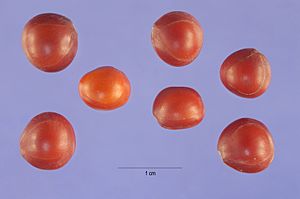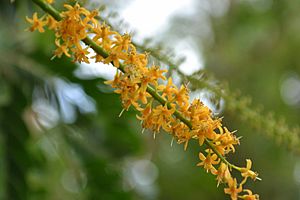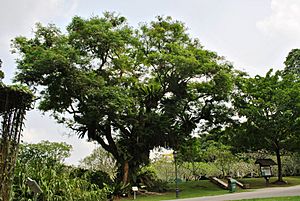Adenanthera pavonina facts for kids
Quick facts for kids Adenanthera pavonina |
|
|---|---|
 |
|
| Adenanthera pavonina manjadi
with the red seeds, India. |
|
| Scientific classification | |
| Kingdom: | |
| (unranked): | |
| (unranked): | |
| (unranked): | |
| Order: | |
| Family: | |
| Genus: |
Adenanthera
|
| Species: |
A. pavonina
|
| Binomial name | |
| Adenanthera pavonina |
|
| Synonyms | |
|
|
The Adenanthera pavonina tree is also known as the Red Lucky Seed tree. It's a type of tree that lives for many years (a perennial tree) and belongs to the legume family. This means it's related to plants like peas and beans.
People use this tree for many things. Its parts can be used for food, traditional medicines, and even wood for building.
Contents
What are the common names for this tree?
The Adenanthera pavonina tree has many interesting names around the world. Its most common name is Red Lucky Seed. This name comes from its bright red, shiny seeds.
Some other names include Acacia Coral, Bead Tree, and Circassian Seed. In India, especially in Kerala, the seeds are called Manjadi. In Tamil Nadu, they are known as Aanai Kundumani. The tree is called Madhoshi Gas in the Maldives, and its seeds are called Madhoshi.
Where does the Red Lucky Seed tree grow?
This tree is very common in warm, tropical parts of the world, especially in older continents like Asia and Africa. It has also been brought to many countries in the Americas.
You can find it growing in places like Brazil, Costa Rica, Honduras, Cuba, and Puerto Rico. It also grows in parts of the United States, especially in southern Florida.
How do people use this tree?
The Red Lucky Seed tree is very useful! It helps the soil by adding important nutrients like nitrogen. Because of this, it's often grown to feed animals (called forage). It's also a popular garden plant or a shade tree in cities because of its attractive shape.
Some parts of the tree can be eaten. For example, the young leaves can be cooked and enjoyed. The raw seeds are not safe to eat, but they can be eaten after they are cooked properly.
The beautiful red seeds have been a symbol of love in China for a long time. They are called xiang si dou, which means "mutual love bean." Because the seeds are so pretty, they are often used to make jewellery like necklaces and bracelets.
Long ago in India, these seeds were used to weigh precious things like gold. This is because the seeds are known to be almost exactly the same weight as each other. The Malay name for the tree, saga, even comes from an Arabic word for 'goldsmith'.
The tree has small, yellowish flowers that grow in hanging bunches. Its curved seed pods split open when they are ripe, showing the hard, scarlet seeds inside. The wood of this tree is very hard and can be used to make soap. A red dye can also be made from the wood. People use the wood for building boats, making furniture, and as firewood.
This tree grows quickly and has a wide, spreading top, which makes it great for providing shade in large gardens or parks. However, it does drop a lot of leaves, small branches, and especially seed pods. The pods crack open while still on the tree, releasing their seeds before falling to the ground.
Red Lucky Seed tree in traditional medicine
In traditional medicine, different parts of the Adenanthera pavonina tree are used to help with health issues. For example, a special tea made from the young leaves and bark is used to help treat diarrhoea.
Also, the ground-up seeds are used to help with inflammation, which is when a part of your body becomes swollen and painful. Some early scientific studies have shown that these traditional uses might be helpful. For instance, studies have found that extracts from the leaves can fight certain bacteria that cause problems in the stomach. Also, high amounts of seed extract have been shown to reduce inflammation in studies with animals.
See also
 In Spanish: Adenanthera pavonina para niños
In Spanish: Adenanthera pavonina para niños




